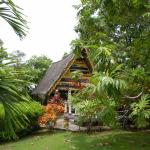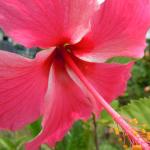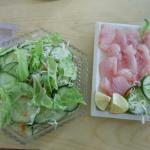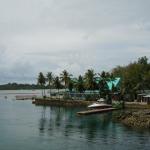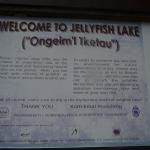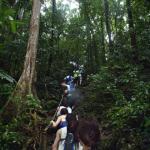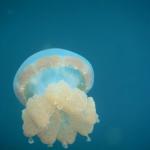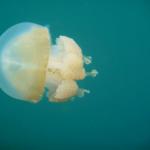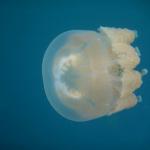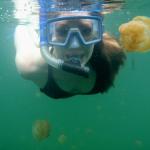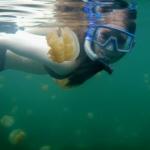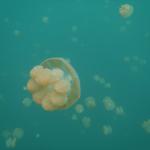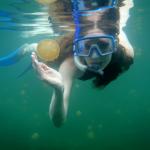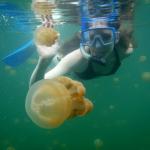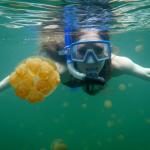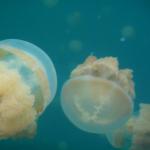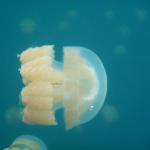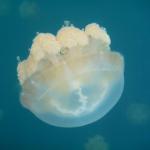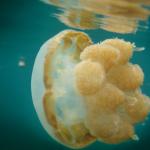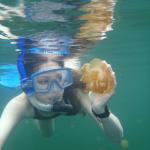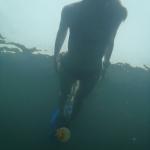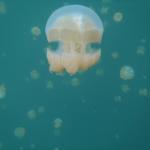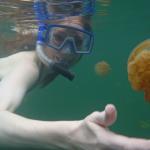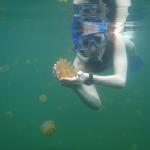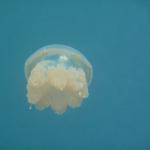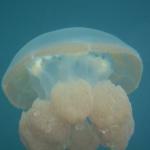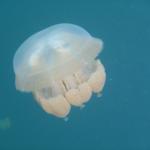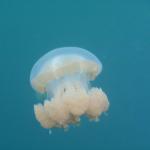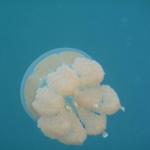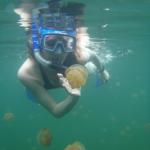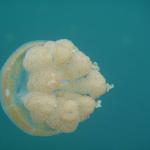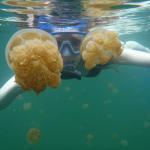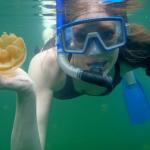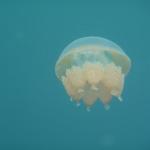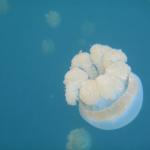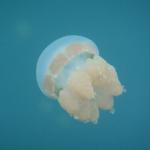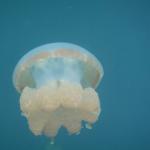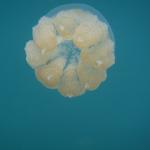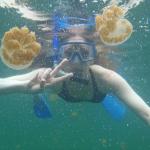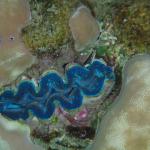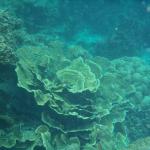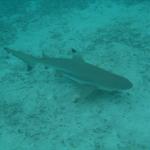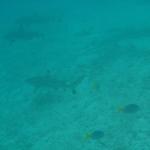© 2011 Sabrina Swenson. All Rights Reserved.
Palau
March, 2011
Swimming with jellyfish usually isn't a very good idea. In the tiny Pacific island nation of Palau, however, swimming with jellyfish is an awe inspiring experience.
The long haul from Germany to the other side of the world took me on flights through Chicago, Tokyo and Guam before reaching Palau. Since I had never been to Guam before I made a stop for a few days on this small island before proceeding to Palau. Guam; 30 miles long and 9 miles at it's widest is located in the Western Pacific Ocean and is an unincorporated US territory and Micronesia's largest and most populous island. Mass amounts of Japanese tourists flock to this tiny island and I found myself the only Caucasian on the flight to Hagatna, the capital of Guam. I rented a car as this is pretty much the only way to get around the island. With limited bus service serving the main town only, public transportation was simply not an option. While driving a loop around the island I found there were some beautiful areas with scenic views of the beaches. The towns themselves, however, I found a bit run down and tired. There is one nice street in the main town with all the high end shops, duty free stores and all the big hotel chains on the nicest part of the beach, but other than this, Guam seemed a bit worn out. The US military claims a large chunk of the Northern part of the island as its base and so travel to this area is restricted. Guam's economy is supported mainly by tourism (mostly from Japan) with it's second source coming from the US military. Although it wasn't my favorite stop in the world, I'm always happy to check out somewhere new.
After a couple days on Guam I caught the 2 hour flight to Palau. The Republic of Palau has officially only been an independent nation since 1994 after 50 years of colonial-style US rule. It still uses the US dollar as it's currency and no visa is needed for Americans. This is always a perk as so many countries require visas and often at hefty prices. I always consider it a bonus when I don't need to obtain one for a country I'm going to. Besides the cost, countries often make it a bit difficult to obtain a visa, it seems, especially if you are American. For instance, for my Yemen visa, in addition to a variety of forms and documentation I also needed a letter of invitation from the Ministry of Interior in Yemen. How in the world am I going to get that, I thought! Luckily, whatever I may lack in any other area, I make up for in persistence. And so, after relentlessly making phone calls, and e-mail inquires to a variety of sources in Yemen I was eventually granted a visa. I'm not sure if I finally spoke with the right person or perhaps they just gave it to me because they were sick of me and my incessant inquiries and nagging. Regardless, the visa was obtained. For tiny Palau, however, Americans just simply need to show up to receive a free one year entry stamp. How pleasantly simple!
I arrived late in the day, in the dark. After calling a hotel I had chosen from my book they quickly picked me up and we were off to the hotel located in Koror, Palau's largest city. (Note, largest city in Palau is still quite tiny by everyone else's standards). Arriving so late, I immediately hit the bed and woke in the morning to a rich, lush jungle view from my hotel room. Palau is beautiful indeed! I got breakfast across the street and then started walking to find a company to take me to Jellyfish Lake.
Jellyfish Lake is approximately 12,000 years old. It's a marine lake located on the Eil Malk island in Palau. Eil Malk is part of the Rock Islands, a group of small, rocky, mostly uninhabited islands in Palau's Southern Lagoon. Palau’s rock islands formed millions of years ago as tectonic forces slowly pushed coral reef out of the ocean, creating land with the characteristics of reefs. There are about 70 other marine lakes located throughout the Rock Islands. Once I found and signed up with a company, I returned early the next morning for the trip. Once underway we first stopped at a lagoon which had the most beautiful green water. One of the guides dove down to bring up handfuls of rich, snow white clay from the bottom. This clay was incredibly moisturizing and everyone in the group put it all over their entire bodies. It is apparently sold at high end shops in Japan and sells for a bundle. After letting it soak in, we all dove into the lagoon to rinse off. We lingered in the water a while before we were once again on our way to Jellyfish lake. Upon arrival, we first had to climb a steep path through the jungle up and back down the other side to get to the lake. Climbing wet, jagged rocks in our wet flip flops was a bit hairy, but a large rope was available to grab to make the climb a bit easier.
Jellyfish Lake has millions of golden jellyfish which migrate horizontally across the lake daily. This lake is connected to the ocean through tunnels in the limestone of reef. Snorkeling only is allowed in the lake as the bubbles caused by scuba divers could harm the jellyfish. Likewise, the bottom of the lake contains high concentrations of hydrogen sulfide which interestingly is almost completely absent from the upper layer. The bottom layer is potentially dangerous for divers who can be poisoned through their skin.
Sunlight is an essential element in the lives of the golden jellyfish which derive their color and much of their energy from algae that live in their tissue. Like all photosynthetic organisms, the algae use sunlight to produce sugars, which they share with their animal hosts. In turn, the jellyfish provides the algae with a safe haven from predators. Just like jellyfish everywhere, the golden jellyfish of Ongeim’l Tketau (Jellyfish Lake's official name) do have stinging cells however, they are not powerful enough to cause harm to humans.
Jellyfish are very delicate animals whose bodies are comprised primarily of water, 96% in fact. Therefore, water provides virtually all of their structural support. Since it's such a delicate animal pulling on their mass of waterlogged tissue will only stretch or quite possibly tear them. We were informed to be careful as we were snorkeling so as not to harm them.
I, and the large group of Japanese tourists with my group all hopped in the water and started snorkeling out to the middle of the lake. As we proceeded we immediately started seeing them. Only a few at first but very quickly multiplying in numbers the closer to the center we got. I felt bad for a small Japanese boy who was screaming up a storm. Apparently he had been stung by a jellyfish years earlier and since most jellyfish have incredibly painful stings that one never forgets, he was terrified to be in the water. His parents kept reasurring him these jellyfish were different and after much young boy screaming after seeing his family holding the jellyfish, he finally believed they were ok to touch and that the painful experience he once encountered was not to be repeated. The water here was a brilliant green blue and the jellyfish a peach color. They varied in size and seemed to pulsate as they moved. You could touch them and as I cradled them delicately in my hand I thought they were the softest thing I'd ever felt; they were as smooth as silk. They actually are lite up inside and it reminded me of a light bulb filament. These jellyfish, on average, live only 6 months to a year. We all snorkeled around gingerly for an hour before having to leave. I was the last one out of the water and could have stayed all day! Once we were all back in the boat we headed to another island for lunch and a bit more snorkeling. Here we saw some black fin sharks as well as some beautiful coral and giant clams.
Once back in Koror I spent a few more lazy days before the long journey back to Europe. Most jellyfish, although beautiful creatures, usually have a horrible sting. It was wonderful to be able to see these up close and touch them without fear of being stung. It was a great experience!

